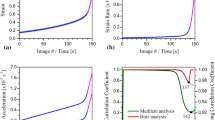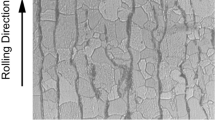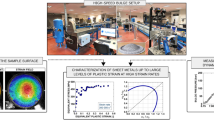Abstract
Strain-based Forming Limit Diagrams (FLD), which are typically obtained under linear or quasi-linear loading conditions, describe the limiting strains in terms of the major and minor in-plane strains before the onset of necking or the final failure (FFD). These strains can be detected by analysing the strain field in the vicinity of necking or cracking defects. It has generally been agreed that the loading versus time signal is not suitable for detecting necking processes. A novel hybrid method of detecting the onset of necking based on the experimental and simulated bulging load is presented in this paper. This method consists mainly in comparing the experimental forming load, i.e., a load showing plastic instability, with the numerical predictions obtained by performing finite element simulation. The simulation of the bulging process does not include any damage or failure criteria. A homogeneous forming load can therefore be simulated without requiring any information about the localization. This method was applied to detecting the onset of local necking in circular and elliptic quasistatic bulge tests on sheet material, with a diameter of 200 mm. Two materials were tested, a 0.8 mm thick DP450 Dual Phase steel sheet and a 1 mm thick AA6016-T4 aluminium sheet. The onset of necking observed with our method was compared with the results obtained by performing Hogström’s analysis based on the measured strain field over time and similar necking strains were obtained. Beside, the Bressian Williams Hill (BWH) shear criterion was identified for each test from experimental results. A slight scattering of the shear stress values was observed.



















Similar content being viewed by others
References
Geiger M, Merklein M (2003) Determination of forming limit diagrams—a new analysis method for characterization of material’s formability. CIRP Ann Manuf Technol 62(1):213–216
Backhofen WA, Keeler SP (1963) Plastic instability and fracture in sheet stretched over rigid punches. ASM Trans Q 56(1):25–48
Goodwin GM (1968) Application of the strain analysis to sheet metal forming problems in the press shop. SAE
Hotz W and Timm J (2008) Experimental determination of forming limit curve (FLC). In proceeding of Numisheet, ISBN 978-3-909386-80-2
Stoughton TB (2000) A general forming limit criterion for sheet metal forming. Int J Mech Sci 42:1–127
Barata da Rocha A, Barlat F, Jalinier JM (1985) Prediction of the forming limit diagrams of anisotropic sheets in linear and non-linear loading. Mater Sci Eng 68:151–164
Brunet M, Morestin F (2001) Experimental and analytical necking studies of anisotropic sheet metals. J Mater Process Technol 112:214–226
Graf AF, Hosford WF (1993) Calculations of forming limit diagrams for changing strain paths. Metall Trans. 2497–2501
Banabic (2000) Formability of metallic materials: plastic anisotropy, formability testing, forming Limit. Springer-Verlag Berlin, Heidelberg, 3-540-67906-5
Marciniak Z, Kuczynski K, Pokora T (1973) Influence of the plastic properties of a material on the forming limit diagram for sheet metal in tension. Int J Mech Sci 15:789–805
Norme ISO 12004–2, Tôles et bandes (2008) Détermination des courbes limite de formage, Afnor
Ozturk F, Lee D (2005) Experimental and numerical analysis of out-of-plane formability test. J Mater Process Technol 170:247–253
Leppin C, Li J, Daniel D (2008) Application of a method to correct the effect of non-proportional strain paths on Nakajima test based forming limit curves. In proceeding of Numisheet 2008 Conf., ISBN 978-3-909386-80-2
Hill R (1950) A theory of the plastic bulging of a metal diaphragm by lateral pressure. Philos Mag Ser 7(41):1133–1142
Norme ISO 12004–1, Tôles et bandes (2008) Détermination des courbes limite de formage, Afnor
Shouler DR, Allwood JM (2010) Design and use of a novel sample design for formability testing in pure shear. J Mater Process Technol 210:1304–1313
Dreyer CE, Chiu WV, Wagoner RH, Agnew SR (2010) Formability of more randomly textured magnesium alloy sheet: application of an improved warm sheet formability. J Mater Process Technol 210:36–47
ARAMIS, manuel d’utilisation, mesure de déformations 3D sans contact.
Hill R (1952) On discontinuous plastic states with special reference to localised necking in thin sheet. J Mech Phys Solids 1:19–30
Marciniak Z, Kuczynski K (1967) Limit strain in the process of stretch-forming sheet metal. Int J Mech Sci 9:609–620
Hogström P, Ringsberg JW, Johnson E (2009) An experimental and numerical study of effect the of length scale and strain rate on the necking and fracture behaviours in sheet metals. Int J Imp Eng 36:1194–1203
Lai M, de Luca P, Brun R, Chambard A (1999) Actual and virtual testing techniques for a numerical definition of materials. Proc NUMISHEET99. 393–398
Petek A, Pepelnjak T, Zuzman K (2005) An improved method for determining forming limit diagram in the digital environment. J Mech Eng 51:330–345
Zang SL, Thuillier S, Le Port A, Manach PY (2011) Prediction of the anisotropy and hardening of metallic sheets in tension, simple shear and biaxial tension. Int J Mech Sci 53:338–347
Butuc MC, Gracio JJ, Barata da Rocha A (2006) An experimental an theoretical analysis on the application of stress-based forming limit criterion. Int J Mech Sci 48:414–429
Bragard A, Baret JC, Bonnarens H (1972) A simplified technique to determine the FLD at onset of necking. CRM 33:53–63
Alsos HS, Hopperstad S, Törnqvist R, Amdahl J (2008) Analytical and numerical analysis of sheet metal instability using a stress based criterion. Int J Solids Struct 45:2042–2045
Rees DWA (2006) Basic engineering plasticity. Butterworth-heinemann
Marciniak Z, Duncan JL, HU SJ (2002) Mechanics of sheet metal forming. Butterworth-Heinemann
Jones N (1997) Structural impact. Cambridge University Press, Cambridge
Grolleau V, Mohr D, Penin A, Gary G, Galpin B (2009) High strain rate bulge testing of a DP450 steel using a nylon SHPB system. DYMAT Int Conf. 597–602
Marron G, et al. (1997) A new necking criterion for the forming limit diagrams, IDDRG 1997 WG Meeting, Haugsenung
Dunand M, Mohr D (2010) Hybrid experimental-numerical analysis of basic ductile fracture experiments for sheet metals. Int J Solids Struct 47:1130–1143
Hill R (1948) A theory of the yielding and plastic flow of anisotropic metals. Proc Roy Soc London 193:281–297
LS-DYNA, Keyword user’manual, volume 1, May 2007, Version 971, Livermore Software Technology Corporation (LSTC)
Author information
Authors and Affiliations
Corresponding author
Appendices
Annex 1
-
The swelling of the bulges was simulated numerically using the LS-DYNA software program [35] in implicit calculations. The die and barrel were modeled in the form of volumic elements with the MAT_RIGID behavioural law, and were therefore assumed to be non-deformable. Water was modeled in the form of volumic elements (Size: 2*2*2 mm) with the MAT_ELASTIC_FLUID behavioural law. The bulk modulus was set at 2.5GPa. The sheet material was modeled using shell elements of the Tsai-Belytschko type with 7 integration points through the thickness. Element size at bulge center was 1.5 × 1.5 mm2 (Fig. 15a). The sample behavioural laws used were the elasto-plastic POWER_LAW_ISOTROPIC_PLASTICITY in the case of Hollomon’s hardening and the 3_PARAMETER_BARLAT in that of Voce’s hardening. Since all the tests were performed at a strain rate of about 10−3 s−1, no strain rate sensitivity was taken into account. The boundary conditions round the edges of the sample were clamped conditions. An experimental piston velocity of 3 mm/min was imposed at the nodes of the water-piston interface using BOUNDARY_PRESCRIBED_MOTION_SET. An example of the mesh used for this purpose is shown in (Fig. 15a). The changes with time in the major and minor strains and the displacement of the apex of the bulge predicted in the simulations are compared in (Figs. 6 and 20) with the experimental data obtained on bulge N°2. Good agreement can be observed to have existed between the simulated and experimental values.
Annex 2
-
γF(h) was calculated in two stages. In the first stage, the ratio R(h) was calculated with various values of h. The values of Fexpe and Fsimu pertaining in the case of identical displacements were not available. Interpolations were therefore performed on the cloud of dots corresponding to the experimental loads, which were simulated using fourth-order polynomials in the windows (width L) centred on the value h* of the displacement at which it was intended to calculate R(h*). Fexpe(h*) and Fsimu(h*) could then be calculated. R(h* + ∆h) was determined by sliding the overlapping interpolation window. We took ∆h = 0.02 L. The value of the function R(h) was therefore known only at some values of h*. Secondly, we again interpolated the dots in R(h) into the window L* using an order 3 polynomial, where the coefficients ai: R(h)=a0+a1h+a2h2+a3h3 were identified. It was then possible to explicitly determine the second derivative of R(h) : γF(h) = 2a2 + 6a3h. It sufficed to slide the overlapping interpolation window in order to calculate γF(h+∆h) in the same way, taking ∆h = 0.01 L*.
The sensitivity of the width of the window was then studied. Decreasing L* was found to result in changes in the value of R(h*), and hence, in that of γF(h*). These values stabilised in a range of L* values before becoming sensitive to changes in L*. The influence of L* observed here was probably attributable to the small number of dots available in the window for defining the polynomial satisfactorily. It was therefore decided to select the size of L* in the range in which R(h*) was stabilised.
Rights and permissions
About this article
Cite this article
Galpin, B., Grolleau, V., Penin, A. et al. A hybrid method for detecting the onset of local necking by monitoring the bulge forming load. Int J Mater Form 9, 161–173 (2016). https://doi.org/10.1007/s12289-015-1219-x
Received:
Accepted:
Published:
Issue Date:
DOI: https://doi.org/10.1007/s12289-015-1219-x





